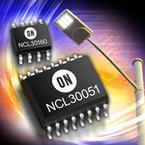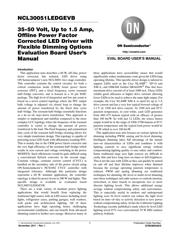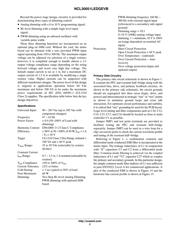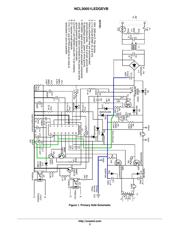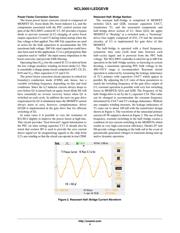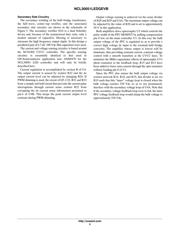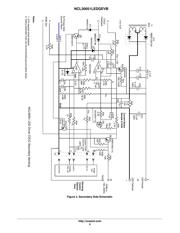herunterladen

© Semiconductor Components Industries, LLC, 2011
November, 2011 − Rev. 1
1 Publication Order Number:
EVBUM2039/D
NCL30051LEDGEVB
35-50 Volt, Up to 1.5 Amp,
Offline Power Factor
Corrected LED Driver with
Flexible Dimming Options
Evaluation Board User's
Manual
Introduction
This application note describes a 60 W, off−line, power
factor corrected, line isolated, LED driver using
ON Semiconductor’s new NCL30051 two−stage controller.
This controller contains the control circuitry for both a
critical conduction mode (CRM) boost power factor
corrector (PFC), and a fixed frequency, series resonant
half−bridge converter, and is housed in a 16 pin SOIC
package. The high level of integration and low pin count is
based on a novel control topology where the PFC output
bulk voltage is adjusted via closed loop to change the
amount of power transferred by the fixed duty cycle
half−bridge. The resonant half−bridge essentially functions
as a dc−to−dc step−down transformer. This approach is
simpler to implement and stabilize compared to the more
complex LCC topology where the frequency of the resonant
controller is varied to change the amount of power
transferred to the load. The fixed frequency and symmetrical
duty cycle of the resonant half−bridge clocking allows for
very simple transformer design. This topology is capable of
powering series LED loads with efficiencies reaching 90%.
This is mainly due to the CRM power factor corrector and
the very high efficiency of the resonant half−bridge which
results in zero current and voltage switching in the power
MOSFETs. Such efficiencies would be quite difficult using
a conventional flyback converter in the second stage.
Constant voltage, constant current control (CVCC) is
handled on the secondary side of the power circuit using
ON Semiconductor’s NCS1002 CVCC controller with
integrated reference. Although this particular design
represents a 60 W nominal application, the controller
topology is ideal for power levels to 200 W and higher. This
specific design is available as evaluation board
NCL30051LEDGEVB.
There are a wide variety of medium power lighting
applications that would benefit from replacing the
traditional light source with an LED source including street
lights, refrigerator cases, parking garages, wall washers,
wall packs and architectural lighting. All of these
applications have high operating hours, challenging
environmental conditions, and can benefit from advanced
dimming control to further save energy. Moreover many of
these applications have accessibility issues that would
significantly reduce maintenance costs given the LEDs long
operating lifetime. This specific driver design is tailored to
support LEDs such as the Cree XLAMPt XP−G and
XM−L, and OSRAM Golden DRAGON
®
Plus that have
maximum drive currents of at least 1000 mA. These LEDs
exhibit good efficacies at higher drive currents allowing
fewer LEDs to be used to achieve the same light output. For
example, the Cree XLAMP XM−L is rated for up to 3 A
drive current and has a very low typical forward voltage of
3.1 V @ 1500 mA drive current. At 1500 mA and 85°C
junction temperature, in cool white, each LED generates
from 440−475 lumens typical with an efficacy of greater
than 100 lm/W. So with just 12 LEDs, the source lumen
output would be in the range of 5200−5700 lumens at 85°C
junction temperature and the typical load power would be
~53 W which is over 100 lm/W.
This application note also focuses on various options for
dimming including PWM, analog and bi−level dimming.
Intelligent dimming takes full advantage of the instant
turn−on characteristics of LEDs and combines it with
lighting controls to save significant energy without
compromising lighting quality or user safety and comfort.
Some traditional large area light sources are difficult to
easily dim and have long turn−on times to full brightness.
This is not the case with LEDs as they can quickly be turned
on and off and their lifetime improves when dimmed
because the average operating junction temperature is
reduced. PWM and analog dimming are traditional
techniques for dimming. Bi−level or multi−level dimming
uses these techniques and adds sensors or controls (motion,
networked, or timer based) to incorporate two or more
discrete lighting levels. This allows additional energy
savings without compromising safety and convenience.
This is especially useful in outdoor and underground
lighting were bi−level control can reduce the light level
based on time−of−day or activity detection to save power
without compromising safety. In fact the California Lighting
Technology recently published a study where bi−level LED
lighting saved 87% over conventional 70 W HID outdoor
pathway bollards.
http://onsemi.com
EVAL BOARD USER’S MANUAL
Verzeichnis

